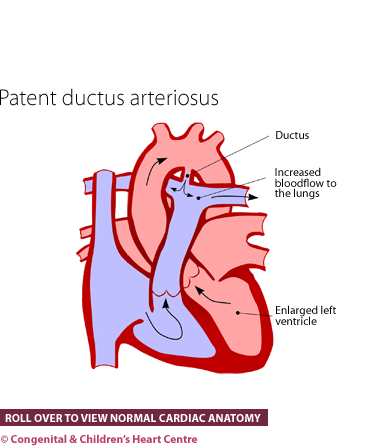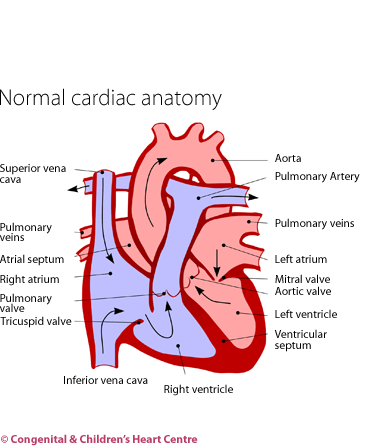Patent Ductus Arteriosus

What is it?
Patent ductus arteriosus or patent arterial duct (PDA) is a condition in which a structure called the ductus arteriosus, normal in fetal life, remains into infancy and onwards, when it should have disappeared.
This duct is present in the unborn baby in the womb and connects the artery that goes to the lungs to that which goes to the body. This duct allows blood to bypass the collapsed lungs, which are not needed before birth. After birth, the duct should shut over the first few days of life. When it stays open, it is known as a PDA.
How many people get it?
There are estimated to be six cases of a PDA out of every 10,000 live births and accounting for about 7% of all congenital heart disease.
Who gets it?
It is common in premature infants, in whom the mechanisms for normal closure may be abnormal. An open duct may be present for the first couple of weeks of life but would then be expected to shut. It can occur in conjunction with other more complicated defects of the heart.
What are the signs and symptoms?
Very small ducts can be discovered as an incidental finding when the infant or child undergoes echocardiography for another reason. These are not heard when listened to with a stethoscope and cause no symptoms.
Small ducts often come to medical attention at routine health checks due to the presence of a murmur (a noise heard when listening to the heart with a stethoscope). There are no symptoms attributable to them.
Medium-sized ducts may come to medical attention due to a murmur but the child may also develop signs of heart failure (breathlessness and sweating on feeding). The baby's growth may be reduced and they may suffer from chest infections. In childhood, their exercise tolerance may be restricted compared with their peers. The child's pulses are usually very strong and easily felt.
Large ducts may come to medical attention due to a murmur but the child usually has severe heart failure, with breathlessness at rest, poor feeding and weight gain and bounding pulses. The child may suffer from chest infections.
What kind of tests might I have?
These infants and children are usually referred to a paediatric cardiologist, who will investigate further. After questioning the parents to obtain the baby's history and examining the child, several tests will be organised.
These may consist of an electrocardiogram (ECG) to measure the electrical activity of the heart and a chest X-ray to visualise the heart and lungs.
The diagnosis is made by echocardiography.
What is the treatment?
- None required. When the duct is very small and inaudible to a stethoscope they are left alone, as they present no risk.
- Drug therapy. In premature babies it may be necessary to close the duct using a medicine called indomethacin or ibuprofen, which stimulates the duct to close. This strategy is usually only successful if the baby is less than 2 weeks of age.
- Surgical ligation. Where the duct is large or the baby small then it may be necessary to close the duct using surgery.
- Device closure at cardiac catheterisation. If the duct is audible and still present at a year of age then coil or plug closure is undertaken internally. A catheter (small tube) is inserted into the leg vein and artery. A coil or plug is inserted into the catheter and then deployed across the duct.
What is the prognosis?
Following closure (whichever technique) the outlook is excellent. Children would be expected to lead a completely normal life, with normal exercise tolerance. In very sick premature babies however, their outcome may depend on their overall condition.
Download Patent Ductus Arteriosus PDF![]()
Further information at The Children's Heart Federation

